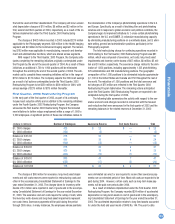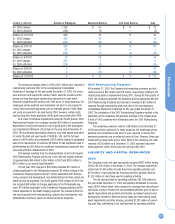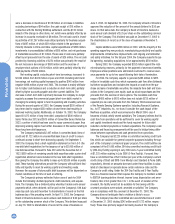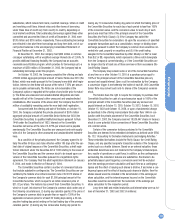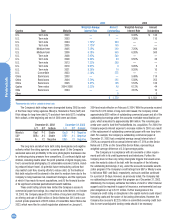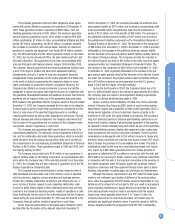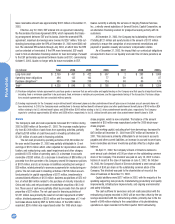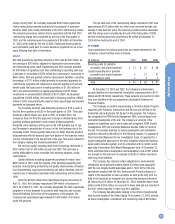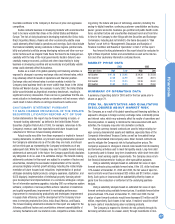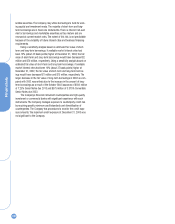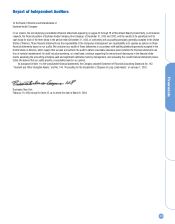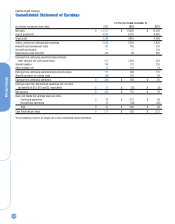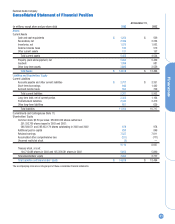Kodak 2003 Annual Report Download - page 34
Download and view the complete annual report
Please find page 34 of the 2003 Kodak annual report below. You can navigate through the pages in the report by either clicking on the pages listed below, or by using the keyword search tool below to find specific information within the annual report.
Financials
34
are accrued for these sites and are included in the $141 million reported
in other long-term liabilities.
As a result of the ongoing monitoring and identification process, the
Company has identified seven additional operating sites with an estimated
future investigation, remediation and monitoring cost of $21 million.
These costs are accrued and are included in the $141 million reported in
other long-term liabilities.
Additionally, the Company has approximately $8 million accrued in
the $141 million reported in other long-term liabilities at December 31,
2003 for remediation relating to other facilities, which are not material to
the Company’s financial position, results of operations, cash flows or com-
petitive position.
Cash expenditures for the aforementioned investigation, remediation
and monitoring activities are expected to be incurred over the next thirty
years for many of the sites. For these known environmental exposures, the
accrual reflects the Company’s best estimate of the amount it will incur
under the agreed-upon or proposed work plans. The Company’s cost esti-
mates were determined using the ASTM Standard E 2137-01, “Standard
Guide for Estimating Monetary Costs and Liabilities for Environmental
Matters,” and have not been reduced by possible recoveries from third
parties. The overall method includes the use of a probabilistic model which
forecasts a range of cost estimates for the remediation required at individ-
ual sites. The projects are closely monitored and the models are reviewed
as significant events occur or at least once per year. The Company’s esti-
mate includes equipment and operating costs for remediation and long-
term monitoring of the sites. The Company does not believe it is reason-
ably possible that the losses for the known exposures could exceed the
current accruals by material amounts.
A Consent Decree was signed in 1994 in settlement of a civil com-
plaint brought by the U.S. Environmental Protection Agency and the U.S.
Department of Justice. In connection with the Consent Decree, the
Company is subject to a Compliance Schedule, under which the Company
has improved its waste characterization procedures, upgraded one of its
incinerators, and is evaluating and upgrading its industrial sewer system.
The total expenditures required to complete this program are currently
estimated to be approximately $16 million over the next five years. These
expenditures are incurred as part of plant operations and, therefore, are
not included in the environmental accrual at December 31, 2003.
The Company is presently designated as a potentially responsible
party (PRP) under the Comprehensive Environmental Response,
Compensation, and Liability Act of 1980, as amended (the Superfund
Law), or under similar state laws, for environmental assessment and
cleanup costs as the result of the Company’s alleged arrangements for
disposal of hazardous substances at four such active sites. With respect to
each of these sites, the Company’s liability is minimal. In addition, the
Company has been identified as a PRP in connection with the non-imaging
health businesses in four active Superfund sites. Numerous other PRPs
have also been designated at these sites. Although the law imposes joint
and several liability on PRPs, the Company’s historical experience demon-
strates that these costs are shared with other PRPs. Settlements and costs
paid by the Company in Superfund matters to date have not been materi-
al. Future costs are also not expected to be material to the Company’s
financial position, results of operations or cash flows.
The Clean Air Act Amendments were enacted in 1990. Expenditures
to comply with the Clean Air Act implementing regulations issued to date
have not been material and have been primarily capital in nature. In addi-
tion, future expenditures for existing regulations, which are primarily capi-
tal in nature, are not expected to be material. Many of the regulations to
be promulgated pursuant to this Act have not been issued.
Uncertainties associated with environmental remediation contingen-
cies are pervasive and often result in wide ranges of outcomes. Estimates
developed in the early stages of remediation can vary significantly. A finite
estimate of cost does not normally become fixed and determinable at a
specific time. Rather, the costs associated with environmental remediation
become estimable over a continuum of events and activities that help to
frame and define a liability, and the Company continually updates its cost
estimates. The Company has an ongoing monitoring and identification
process to assess how the activities, with respect to the known expo-
sures, are progressing against the accrued cost estimates, as well as to
identify other potential remediation sites that are presently unknown.
Estimates of the amount and timing of future costs of environmental
remediation requirements are necessarily imprecise because of the con-
tinuing evolution of environmental laws and regulatory requirements, the
availability and application of technology, the identification of presently
unknown remediation sites and the allocation of costs among the poten-
tially responsible parties. Based upon information presently available, such
future costs are not expected to have a material effect on the Company’s
competitive or financial position. However, such costs could be material to
results of operations in a particular future quarter or year.
NEW ACCOUNTING PRONOUNCEMENTS
In January 2003, the FASB issued Interpretation No. 46 (FIN 46),
“Consolidation of Variable Interest Entities,” an Interpretation of Accounting
Research Bulletin (ARB) No. 51, “Consolidated Financial Statements.” FIN
46 addresses the consolidation by business enterprises of variable interest
entities (VIEs) either: (1) that do not have sufficient equity investment at
risk to permit the entity to finance its activities without additional subordi-
nated financial support, or (2) in which the equity investors lack an essen-
tial characteristic of a controlling financial interest. In December 2003, the
FASB completed deliberations of proposed modifications to FIN 46
(Revised Interpretations) resulting in multiple effective dates based on the
nature and creation date of the VIE. The Revised Interpretations must be
applied to all VIEs no later than the end of the first interim or annual
reporting period ending after March 15, 2004. However, prior to the
required application of the Revised Interpretations, its provisions must be
adopted by the end of the first interim or annual reporting period that ends
after December 15, 2003 (for the year ended December 31, 2003 for the
Company) for VIEs considered to be special purpose entities (SPEs). SPEs
for this provision include any entity whose activities are primarily related
to securitizations or other forms of asset-backed financings or single-les-
see leasing arrangements. The Company’s only material SPE as of
December 31, 2003 was related to its equity investment in ESF. Refer to
Note 7, “Investments,” for the disclosures required under FIN 46 on ESF.
The Company is currently evaluating the effect that the adoption of FIN 46
for non-SPE VIEs created prior to February 1, 2003 will have on its finan-
cial position, results of operations and cash flows. The Company did not
have a material exposure to loss as of December 31, 2003 in relation to



